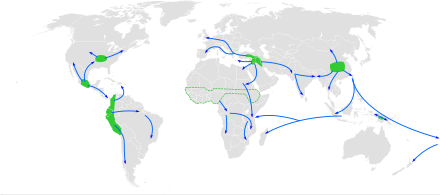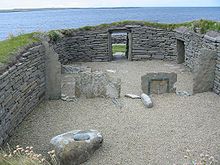Agricultural transition[edit]
The term Neolithic Revolution was coined in 1923 by V. Gordon Childe to describe the first in a series of agricultural revolutions in Middle Eastern history. The period is described as a "revolution" to denote its importance, and the great significance and degree of change affecting the communities in which new agricultural practices were gradually adopted and refined.
The beginning of this process in different regions has been dated from 10,000 to 8,000 BC in the Fertile Crescent[3][7] and perhaps 8000 BC in the Kuk Early Agricultural Site of Melanesia[8][9] to 2500 BC in Subsaharan Africa, with some[who?] considering the developments[clarification needed] of 9000–7000 BC in the Fertile Crescent to be the most important. This transition everywhere seems associated with a change from a largely nomadic hunter-gatherer way of life to a more settled, agrarian-based one, with the inception of thedomestication of various plant and animal species—depending on the species locally available, and probably also influenced by local culture. Recent archaeological research suggests that in some regions such as the Southeast Asian peninsula, the transition from hunter-gatherer to agriculturalist was not linear, but region-specific.[10]
There are several competing (but not mutually exclusive) theories as to the factors that drove populations to take up agriculture. The most prominent of these are:
- The Oasis Theory, originally proposed by Raphael Pumpelly in 1908, popularized by V. Gordon Childe in 1928 and summarised in Childe's book Man Makes Himself.[11] This theory maintains that as the climate got drier due to the Atlantic depressions shifting northward, communities contracted to oases where they were forced into close association with animals, which were then domesticated together with planting of seeds. However, today this theory has little support amongst archaeologists because subsequent climate data suggests that the region was getting wetter rather than drier.[12]
- The Hilly Flanks hypothesis, proposed by Robert Braidwood in 1948, suggests that agriculture began in the hilly flanks of the Taurus and Zagros mountains, where the climate was not drier as Childe had believed, and fertile land supported a variety of plants and animals amenable to domestication.[13]
- The Feasting model by Brian Hayden[14] suggests that agriculture was driven by ostentatious displays of power, such as giving feasts, to exert dominance. This required assembling large quantities of food, which drove agricultural technology.
- The Demographic theories proposed by Carl Sauer[15] and adapted by Lewis Binford[16] and Kent Flannery posit an increasingly sedentary population that expanded up to the carrying capacity of the local environment and required more food than could be gathered. Various social and economic factors helped drive the need for food.
- The evolutionary/intentionality theory, developed by David Rindos[17] and others, views agriculture as an evolutionary adaptation of plants and humans. Starting with domestication by protection of wild plants, it led to specialization of location and then full-fledged domestication.
- Peter Richerson, Robert Boyd, and Robert Bettinger[18] make a case for the development of agriculture coinciding with an increasingly stable climate at the beginning of the Holocene. Ronald Wright's book and Massey Lecture Series A Short History of Progress[19] popularized this hypothesis.
- The postulated Younger Dryas impact event, claimed to be in part responsible for megafauna extinction and ending the last glacial period, could have provided circumstances that required the evolution of agricultural societies for humanity to survive.[20] The agrarian revolution itself is a reflection of typical overpopulation by certain species following initial events during extinction eras; this overpopulation itself ultimately propagates the extinction event.
- Leonid Grinin argues that whatever plants were cultivated, the independent invention of agriculture always took place in special natural environments (e.g., South-East Asia). It is supposed that the cultivation of cereals started somewhere in the Near East: in the hills of Palestine or Egypt. So Grinin dates the beginning of the agricultural revolution within the interval 12,000 to 9,000 BP, though in some cases the first cultivated plants or domesticated animals' bones are even of a more ancient age of 14–15 thousand years ago.[21]
- Andrew Moore suggested that the Neolithic Revolution originated over long periods of development in the Levant, possibly beginning during the Epipaleolithic. In "A Reassessment of the Neolithic Revolution",Frank Hole further expanded the relationship between plant and animal domestication. He suggested the events could have occurred independently over different periods of time, in as yet unexplored locations. He noted that no transition site had been found documenting the shift from what he termed immediate and delayed return social systems. He noted that the full range of domesticated animals (goats, sheep,cattle and pigs) were not found until the sixth millennium at Tell Ramad. Hole concluded that "close attention should be paid in future investigations to the western margins of the Euphrates basin, perhaps as far south as the Arabian Peninsula, especially where wadis carrying Pleistocene rainfall runoff flowed."[22]


No comments:
Post a Comment